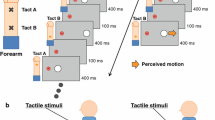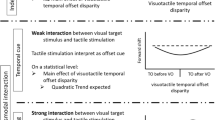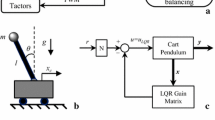Abstract
Previous research suggests that motor actions are intentionally generated by recollecting their sensory consequences. Whereas this has been shown to apply to visual or auditory consequences in the environment, surprisingly little is known about the contribution of immediate, body-related consequences, such as proprioceptive and tactile reafferences. Here, we report evidence for a contribution of vibrotactile reafferences to action selection by using a response–effect compatibility paradigm. More precisely, anticipating actions to cause spatially incompatible vibrations delayed responding to a small but reliable degree. Whereas this observation suggests functional equivalence of body-related and environment-related reafferences to action control, the future application of the described experimental procedure might reveal functional peculiarities of specific types of sensory consequences in action control.



Similar content being viewed by others
Notes
The first explicit distinction of body-related and environment-related effects appeared under the labels of “resident” and “remote” effects (James 1890; cf. Janczyk et al. 2009; Pfister and Kunde 2013). We consider the present wording of body- vs. environment-related effects to be more intuitive, however.
Condition order had a rather pronounced impact on the RT data in this experiment. All reported effects, however, are significant (and slightly more pronounced) when controlling for order by including it as an additional between-subjects factor in the reported ANOVAs.
References
Ansorge U (2002) Spatial intention-response compatibility. Acta Psychol 109:285–299
Badets A, Koch I, Toussaint L (2013) Role of an ideomotor mechanism in number processing. Exp Psychol 60:34–43
Dutzi IB, Hommel B (2009) The microgenesis of action-effect binding. Psychol Res 73:425–435
Elsner B, Hommel B (2001) Effect anticipation and action control. J Exp Psychol Hum 27:229–240
Frings C, Rothermund K, Wentura D (2007) Distractor repetitions retrieve previous responses to targets. Q J Exp Psychol 60:1367–1377
Frings C, Amendt A, Spence C (2011) When seeing doesn’t matter: assessing the after-effects of tactile distractor processing in the blind and the sighted. J Exp Psychol Hum 37:1174–1181
Frings C, Larra M, Gräbener A, Moeller B, Schächinger H (2013a) Stress disrupts distractor-based retrieval of SR episodes. Biol Psychol 93:58–64
Frings C, Moeller B, Rothermund K (2013b) Retrieval of event files can be conceptually mediated. Atten Percept Psychophys 75:700–709
Gaschler R, Nattkemper D (2012) Instructed task demands and utilization of action effect anticipation. Frontiers Psychol 3. doi:10.3389/fpsyg.2012.00578
Giesen C, Rothermund K (2011) Affective matching moderates S–R binding. Cogn Emot 25:342–350
Greenwald AG (1970) A choice reaction time test of ideomotor theory. J Exp Psychol 86:20–25
Harleß E (1861) Der Apparat des Willens [The Apparatus of Will]. Zeitschrift für Philosophie und philosophische Kritik 38:50–73
Herbart JF (1825) Psychologie als Wissenschaft neu gegründet auf Erfahrung, Metaphysik und Mathematik [Psychology as a science newly founded on experience, metaphysics, and mathematics]. August Wilhelm Unzer, Königsberg
Herbort O, Butz MV (2012) Too good to be true? Ideomotor theory from a computational perspective. Frontiers Psychol 3:494. doi:10.3389/fpsyg.2012.00494
Herwig A, Horstmann G (2011) Action-effect associations revealed by eye movements. Psychon Bull Rev 18:531–537
Herwig A, Waszak F (2012) Action-effect bindings and ideomotor learning in intention- and stimulus-based actions. Frontiers Psychol 3:444. doi:10.3389/fpsyg.2012.00444
Herwig A, Prinz W, Waszak F (2007) Two modes of sensorimotor integration in intention-based and stimulus-based actions. Q J Exp Psychol 60:1540–1554
Hoffmann J (1993) Vorhersage und Erkenntnis: Die Funktion von Antizipationen in der menschlichen Verhaltenssteuerung und Wahrnehmung [Prediction and Realisation: The function of anticipations in human behavioural control and perception]. Hogrefe, Göttingen
Hoffmann J, Lenhard A, Sebald A, Pfister R (2009) Movements or targets: what makes an action in action effect learning? Q J Exp Psychol 62:2433–2449
Hommel B (1993) Inverting the Simon effect by intention. Psychol Res 55:270–279
Hommel B (2009) Action control according to TEC (theory of event coding). Psychol Res 73:512–526
Hommel B, Müsseler J, Aschersleben G, Prinz W (2001) The theory of event coding (TEC): a framework for perception and action planning. Behav Brain Sci 24:849–937
Hubbard J, Gazzaley A, Morsella E (2011) Traditional response interference effects from anticipated action outcomes: a response–effect compatibility paradigm. Acta Psychol 138:106–110
James W (1890/1981) The principles of psychology, vol 2. Harvard University Press, Cambridge
Janczyk M, Skirde S, Weigelt M, Kunde W (2009) Visual and tactile action effects determine bimanual coordination performance. Hum Mov Sci 28:437–449
Janczyk M, Pfister R, Crognale MA, Kunde W (2012a) Effective rotations: action-effects determine the interplay of mental and manual rotations. J Exp Psychol Gen 141:489–501
Janczyk M, Pfister R, Kunde W (2012b) On the persistence of tool-based compatibility effects. J Psychol 220:16–22
Janczyk M, Heinemann A, Pfister R (2012c) Instant attraction: immediate action-effect bindings occur for both, stimulus- and goal-driven actions. Frontiers Psychol 3:446. doi:10.3389/fpsyg.2012.00446
Keller PE, Koch I (2006) Exogenous and endogenous response priming with auditory stimuli. Adv Cogn Psychol 2:269–276
Koch I, Kunde W (2002) Verbal response–effect compatibility. Mem Cogn 30:1297–1303
Krieghoff V, Brass M, Prinz W, Waszak F (2009) Dissociating what and when of intentional actions. Frontiers Hum Neurosci 3:1–10
Kühn S, Elsner B, Prinz W, Brass M (2009) Busy doing nothing: evidence for nonaction-effect binding. Psychon Bull Rev 16:542–549
Kunde W (2001) Response–effect compatibility in manual choice reaction tasks. J Exp Psychol Hum 27:387–394
Kunde W (2003) Temporal response–effect compatibility. Psychol Res 67:153–159
Kunde W, Koch I, Hoffmann J (2004) Anticipated action effects affect the selection, initiation, and execution of actions. Q J Exp Psychol 57:87–106
Kunde W, Lozo L, Neumann R (2011) Effect-based control of facial expressions. Evidence from action-effect compatibility. Psychon Bull Rev 18:820–826
Kunde W, Pfister R, Janczyk M (2012) The locus of tool-transformation costs. J Exp Psychol Hum 38:703–714
Ladwig S, Sutter C, Müsseler J (2012) Crosstalk between proximal and distal action effects during tool use. J Psychol 220:10–15
Lotze HR (1852) Medicinische Psychologie oder Physiologie der Seele [Medical psychology or the physiology of the mind]. Weidmann’sche Buchhandlung, Leipzig
Moeller B, Frings C (2011) Remember the touch: tactile distractors retrieve previous responses to targets. Exp Brain Res 72:2176–2183
Nattkemper D, Ziessler M, Frensch PA (2010) Binding in voluntary action control. Neurosci Biobehav Rev 34:1092–1101
Oriet C, Stevanovski B, Jolicoeur P (2001) Theory of event coding: interesting, but underspecified. Behav Brain Sci 24:897–898
Pfister R, Janczyk M (2012) Harleß’ apparatus of will: 150 years later. Psychol Res 76:561–565
Pfister R, Janczyk M (2013) Confidence intervals for two sample means: calculation, interpretation, and a few simple rules. Adv Cogn Psychol 9:74–80
Pfister R, Kunde W (2013) Dissecting the response in response–effect compatibility. Exp Brain Res 224:647–655
Pfister R, Kiesel A, Melcher T (2010) Adaptive control of ideomotor effect anticipations. Acta Psychol 135:316–322
Pfister R, Kiesel A, Hoffmann J (2011) Learning at any rate: action-effect learning for stimulus-based actions. Psychol Res 75:61–65
Pfister R, Schwarz KA, Janczyk M (2012) Ubi irritatio, ibi affluxus: a 19th century perspective on haemodynamic brain activity. Cortex 48:1061–1063
Pfister R, Dignath D, Hommel B, Kunde W (2013) It takes two to imitate: anticipation and imitation in social interaction. Psychol Sci 24(10):2117–2121
Prinz W (1990) A common coding approach to perception and action. In: Neumann O, Prinz W (eds) Relationships between perception and action. Springer, Heidelberg, pp 167–201
Prinz W (1992) Why don’t we perceive our brain states? Eur J Cogn Psychol 4:1–20
Prinz W (1997) Perception and action planning. Eur J Cogn Psychol 9:129–154
Rieger M (2007) Letters as visual action-effects in skilled typing. Acta Psychol 126:138–153
Ruge H, Krebs RM, Wolfensteller U (2012) Early markers of ongoing action-effect learning. Frontiers Psychol 3:522. doi:10.3389/fpsyg.2012.00522
Sanders AF (2001) How specific and common is common coding? Behav Brain Sci 24:903–905
Shin YK, Proctor RW (2012) Testing boundary conditions of the ideomotor hypothesis using a delayed response task. Acta Psychol 141:360–372
Shin YK, Proctor RW, Capaldi EJ (2010) A review of contemporary ideomotor theory. Psychol Bull 136:943–974
Stock A, Stock C (2004) A short history of ideo-motor action. Psychol Res 68:176–188
Thorndike EL (1913) Ideo-motor action. Psychol Rev 20:91–106
Wolfensteller U, Ruge H (2011) On the timescale of stimulus-based action-effect learning. Q J Exp Psychol 64:1273–1289
Acknowledgments
This research was supported by a grant from the German Research Council (Deutsche Forschungsgemeinschaft; DFG) to Wilfried Kunde (Ku 1964/2-2).
Author information
Authors and Affiliations
Corresponding author
Rights and permissions
About this article
Cite this article
Pfister, R., Janczyk, M., Gressmann, M. et al. Good vibrations? Vibrotactile self-stimulation reveals anticipation of body-related action effects in motor control. Exp Brain Res 232, 847–854 (2014). https://doi.org/10.1007/s00221-013-3796-6
Received:
Accepted:
Published:
Issue Date:
DOI: https://doi.org/10.1007/s00221-013-3796-6




